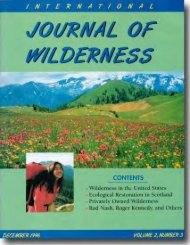Download full PDF - International Journal of Wilderness
Download full PDF - International Journal of Wilderness
Download full PDF - International Journal of Wilderness
You also want an ePaper? Increase the reach of your titles
YUMPU automatically turns print PDFs into web optimized ePapers that Google loves.
“. . . with a significant number <strong>of</strong> wildernesses<br />
containing inholdings, timely and effective solutions<br />
to the problems surrounding wilderness inholdings<br />
are needed.”<br />
Adherence to <strong>Wilderness</strong> Legislation<br />
and Legal Clarification<br />
While, in most cases, agencies managing<br />
designated wilderness are required<br />
to grant access (not necessarily<br />
motorized access) to inholdings, the<br />
access granted is conditional and depends<br />
upon the wilderness designation<br />
legislation and TWA. Thus,<br />
agencies have an opportunity to practice<br />
wise stewardship by denying any<br />
access that is contrary to fundamental<br />
wilderness principles (Figure 3). For<br />
example, an inholder in the Absorka-<br />
Beartooth <strong>Wilderness</strong> recently requested<br />
that the USFS construct an<br />
8.6-mile road to his inholding and<br />
grant motorized access. The USFS denied<br />
the request based on the concern<br />
for the preservation <strong>of</strong> the wilderness<br />
character. The USFS decision was upheld<br />
in a federal district court. We recommend<br />
that managers prioritize<br />
wilderness protection over the convenience<br />
<strong>of</strong> inholders, and existing legislation<br />
will enable them to preserve<br />
wilderness character in most cases.<br />
Land Trusts<br />
Ultimately, it may be advantageous for<br />
agencies managing wilderness to purchase<br />
all private and state land<br />
inholdings in order to preserve wilderness<br />
character in the designated area.<br />
However, such an approach is expensive,<br />
and, consequently, agencies are<br />
unable to afford to purchase all wilderness<br />
inholdings. In the event that<br />
an agency is unable to purchase an<br />
inholding from a willing seller, land<br />
trusts—organizations devoted to acquiring<br />
lands for conservation—can<br />
purchase the land and hold it in the<br />
spirit <strong>of</strong> wilderness stewardship, or sell<br />
the land to the agency when more<br />
public funding for land purchases is<br />
available. Land trusts have traditionally<br />
been an effective tool in combating<br />
problems with wilderness<br />
inholdings. For example, since its<br />
origination in 1992, The <strong>Wilderness</strong><br />
Land Trust (2002) has acquired 180<br />
private inholdings in 35 designated<br />
wildernesses.<br />
Condemnation <strong>of</strong> <strong>Wilderness</strong><br />
Inholdings<br />
The Fifth Amendment <strong>of</strong> the U.S. Constitution<br />
allows federal agencies to<br />
condemn lands if the lands are for<br />
public use. TWA does permit condemnation<br />
<strong>of</strong> lands, but does not grant this<br />
authority to federal agencies. Instead,<br />
it is stipulated in Section 5(c) <strong>of</strong> the<br />
act that authorization by the U.S. Congress<br />
is necessary to condemn lands<br />
within wilderness boundaries. With<br />
the passage <strong>of</strong> the EWA, 16 national<br />
forest wildernesses were established<br />
east <strong>of</strong> the 100th meridian, and the<br />
USFS was authorized to condemn<br />
inholdings in these particular wildernesses<br />
if its use was found to be incompatible<br />
with the protection <strong>of</strong> the<br />
wilderness and the owners were unwilling<br />
to discontinue the incompatible<br />
use. No inholdings have been<br />
condemned under the EWA. While<br />
14 <strong>International</strong> <strong>Journal</strong> <strong>of</strong> <strong>Wilderness</strong> DECEMBER 2002 • VOLUME 8, NUMBER 3<br />
condemnation as a way for managers<br />
to solve a problem is a last resort, it<br />
may be necessary for the preservation<br />
<strong>of</strong> the wilderness character.<br />
Conclusion<br />
The management <strong>of</strong> designated wildernesses<br />
in the NWPS has <strong>of</strong>ten<br />
been an arduous and delicate task. As<br />
outlined in this article, the five types<br />
<strong>of</strong> problems stemming from wilderness<br />
inholdings certainly raise concerns<br />
among wilderness managers. For<br />
many wildernesses, there is potential<br />
for a few inholdings to shape the<br />
character <strong>of</strong> the entire wilderness.<br />
Thus, with a significant number <strong>of</strong><br />
wildernesses containing inholdings,<br />
timely and effective solutions to the<br />
problems surrounding wilderness<br />
inholdings are needed.<br />
REFERENCES<br />
Civiletti, Benjamin R. 1980. Opinion <strong>of</strong> the<br />
Attorney General <strong>of</strong> the United States. Rights<strong>of</strong>-Way<br />
Across National Forests. June 23,<br />
1980.<br />
Clifford, Hal. 2000. Bulldozer backmail. Ski<br />
Magazine (February): 117–121.<br />
Interior Board <strong>of</strong> Land Appeals. 1984. United<br />
States Department <strong>of</strong> the Interior, Office <strong>of</strong><br />
Hearings and Appeals, Interior Board <strong>of</strong> Land<br />
Appeals. IBLA 83-356. March 30, 1984.<br />
Montana <strong>Wilderness</strong> Association v. United<br />
States Forest Service. United States Court <strong>of</strong><br />
Appeals, Ninth Circuit. 1981. No. 80-3374.<br />
August 19, 1981.<br />
The <strong>Wilderness</strong> Land Trust. 2000. Retrieved July 9,<br />
2002, from http://www.wildernesslandtrust.org.<br />
The <strong>Wilderness</strong> Society. 2001. Alaska National<br />
Interest Lands Conservation Act—A Citizens<br />
Guide. Palmer, Alaska: The <strong>Wilderness</strong><br />
Society.<br />
Zaslowsky, Dyan. 1986. These American Lands:<br />
Parks, <strong>Wilderness</strong>, and Public Lands. Washington<br />
D.C.: Island Press.<br />
RANDY TANNER wrote this article in<br />
conjunction with research done at<br />
<strong>Wilderness</strong> Watch. Randy is currently a<br />
graduate student at the University <strong>of</strong><br />
Montana. E-mail:<br />
rtanner@backpacker.com.










